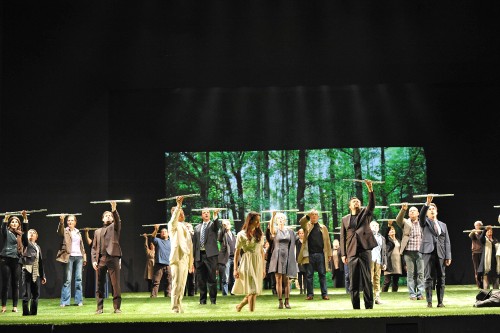 |
| Blindfolds. I'm tired of 'em. Someone else can explain 'em this time. |
Everyone else steps in from the chorus to be or do whatever is
needed to move the story along and get the two couples united in the end; then
they meld back into the ensemble.
Even the Queen of the Night and Sarastro
disappear into the crowd when they are not taking an active role on stage. And
they are not the mythic figures we’re used to seeing. He is a pleasant-looking
gentleman in a suit; and she is a chic if somewhat high-strung woman in a
little black dress. Monostatos is neither black or in blackface (thank
goodness) but a grave digger with an evil streak. Papagena, in old-lady drag,
first appears from a casket, looking like she stepped out of Tim Burton's Corpse
Bride.
| A chic Queen of the Night |
Alliances
are not what we expect in this production. About half-way through the opera, it
becomes clear that Sarastro and the Queen of the Night are working together. Everyone (the whole gathering) really wants the kids to end up together. She
is supportively nearby when Sarastro sends Pamina in to help Tamino with
his trials. And they lead the couple together at the end.
It
reminds me a bit of The Fantasticks,
where the dads convince their kids to get together by making the union
forbidden and difficult. I like the concept, but I’m not 100% convinced by this
staging.
It is nice, however, to see everyone
reconciled—even the Three Ladies and Monostatos—tutti contenti at the end.
 |
| Tamino, Papageno, und der Schlange. |
The
three couples in this opera are convincingly sung and nicely contrasted. Pavol Breslik and Kate Royal as Tamino and Pamina are pleasing with their smooth
lyrical voices. Ana Durlovski and Dimitry Ivashchenko are royal, though not as
dark as expected—and that’s OK—as the Queen of the Night and Sarastro.
Papageno
is a pretty difficult to mess up, unless the baritone either has no character
at all, or can’t sing. Michael Nagy has nether issue and is charming, smooth-voiced,
and engaging in the role. His Papagena, Regula Mühlemann, is equally
charming.
 |
| The Three Ladies' Cadenza |
Festival
settings permit some luxury casting, José van Dam un-retires briefly to
play the Speaker; and much has been made of the starry casting of the Three
Ladies: Annick Massis, Magdalena Kožená, and Nathalie Stutzmann. I couldn’t help
wondering if these three divas were a handful during staging. They seem to be
having fun, but are never quite in synch.
They were always in sync musically,
though—great blend, great balance, and a great cadenza at the end of their opening trio (musically set up just
like an opera seria cadenza.) I didn’t
even know there was a cadenza there.
Although it doesn’t do much for the drama, they do have fun with it, both
musically and dramatically. However one can understand why it’s not usually
(ever?) performed. Other singers added discreet ornamentation, which
pleasantly distinguished this performance from “all the rest.”
 |
| Magic Flutes for everyone! |
There
are a few synchronization issues between the stage and the pit, probably a
result of the short rehearsal time. I usually
admire Simon Rattle’s work, and he does nothing egregious here. On the
other hand, he seems to set some rather willful and unprovoked tempo extremes
now and then. At one point in Act 2, I feared the singers would be completely
left in the dust.
That said, it's a well-sung, well-played performance. The Berlin Philharmonic is a heck of a great pit orchestra. All in all, this
Zauberflöte is a great way to spend an afternoon or evening. It'll be available at Arte Liveweb for about 80 more days.
The Berliner Philharmoniker also presented Zauberflöte in concert last night (April 9) in the Philharmonie, with the same principal cast. The concert can be viewed (soon) at the Digital Concert Hall.
Related Links
The Berliner Philharmoniker also presented Zauberflöte in concert last night (April 9) in the Philharmonie, with the same principal cast. The concert can be viewed (soon) at the Digital Concert Hall.
Related Links
Preview Die Zauberflöte in Baden-Baden
The cadenza appeared in the autograph, but it seems that it was soon deleted by Mozart himself. It comes as an appendix in some editions. I agree with the composer's final opinion about it.
ReplyDeleteI agree. It was fun to hear it but Herr Mozart (as if he needs MY approval) definitely made the right choice.
Delete